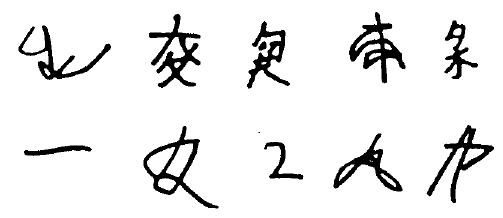1989 - Seeing Voices (18 page)
Read 1989 - Seeing Voices Online
Authors: Oliver Sacks

 POINTING LIGHT MOTION
POINTING LIGHT MOTION
 DEAF CHINESE CHILDREN
DEAF CHINESE CHILDREN
 HEARING CHINESE CHILDREN
HEARING CHINESE CHILDREN
Figure
4. Asked to reproduce a Chinese pseudo-character (presented as a moving point-light display), deaf Chinese children do extremely well, and hearing Chinese children extremely badly. (Reprinted by permission from ‘Dyslexia: Perspectives from Sign and Script,’ U. Bellugi, Q. Tzeng, E.S. Klima, and A. Fok. In A. Galahurda, ed.
From Reading to Neurons
. The MIT Press⁄Bradford Press, 1989.)
The ability to separate discrete configurations, or ‘frames,’ from a continuous stream of movement (as was done with the Chinese pseudo-characters) brings out another important ability of signers—their enhanced power of ‘movement parsing.’ This is seen as being analogous to the ability to break down and analyze speech from a continuous and ever-changing pattern of sound waves. All of us have this ability in the auditory sphere—but only signers have it so dramatically in the visual sphere. And this too, of course, is essential to the comprehension of a visual language, which is extended in time as well as in space.
Is it possible to detect a cerebral basis for such enhancements of spatial cognition? Neville has studied the physiological correlates for such perceptual changes, by measuring changes in the brain’s electrical responses (evoked potentials) to visual stimuli in particular, movements in the peripheral visual field.
108
(Enhanced perception of such stimuli is crucial in Sign communication, for the signer’s eyes are generally fixed on the other’s face, and signing movements of the hands therefore lie in the periphery of the visual field.)
108. For an overview of Neville’s work, see Neville, 1988, and Neville, 1989.
She has compared these responses in three groups of subjects: deaf native signers, hearing non-signers, and hearing native signers (usually born of deaf parents).
Deaf signers show greater speed of reaction to these stimuli—and this goes with an increase of evoked potentials in the occipital lobes of the brain, the primary reception areas for vision. Such increases of speed and occipital potentials were not observed in any of the hearing subjects, and seem to reflect a compensatory phenomenon—the enhancement of one sense in place of another (greater auditory sensitivities, similarly, may occur in the blind).
109
109. The ancient insight that the loss of hearing may cause a ‘compensation’ of sight cannot be ascribed simply to the use of Sign. All deaf—even the postlingually deaf, who stay in the world of speech—achieve some heightening of visual sensibility, and a move toward a more visual orientation in the world, as David Wright describes:
I do not notice more but notice differently. What I do notice, and notice acutely because I have to, because for me it makes up almost the whole of the data necessary for the interpretation and diagnosis of events, is movement where objects are concerned; and in the case of animals and human beings, stance, expression, walk, and gesture…For example, as somebody waiting impatiently for a friend to finish a telephone conversation with another knows when it is about to end by the words said and the intonation of the voice, so does a deaf man—like a person queuing outside a glass-panelled call-box—judge the moment when the good-byes are being said or the intention formed to replace the receiver. He notices a shift of the hand cradling the instrument, a change of stance, the head drawing a fraction of a millimeter from the earphone, a slight shuffling of the feet, and that alteration of expression which signals a decision taken. Cut off from auditory clues he learns to read the faintest visual evidence (Wright, 1969, p. 112
).A similar acuity may also occur, and persist, in the hearing children of deaf parents. Thus in the case described by Arlow (1976):
The patient would look intently at his parents’ faces from early childhood on…[He] became extremely sensitive to intentions and meanings which can be communicated through expressions on the face…Like his [deaf] father, he was particularly sensitive to people’s faces and could make good judgements about the intentions and sincerity of those with whom he was engaged in business…[he] felt that in ordinary business negotiations he had a serious advantage over his opposite numbers
.
But there were also enhancements at higher levels: the deaf subjects showed greater accuracy in detecting the direction of motion, especially when the movement was in the right visual field, and coincident with this was an increase in evoked potentials in the parietal regions of the left hemisphere. These enhancements were also observed in the hearing children of deaf parents and have therefore to be seen not as an effect of deafness, but as an effect of the early acquisition of Sign (which demands very superior perception of visual stimuli). It is not only detection of motion in the peripheral field that is shifted, in signers, from being a right hemisphere to a left hemisphere function. Neville and Bellugi obtained evidence—indeed, quite early on—for a similar left hemisphere specialization (and shift from the ‘normal’ right hemisphere specialization) in deaf signers for picture identification, dot localization, and the recognition of faces.
110
110. Neville and Bellugi, 1978. It should not be supposed that all visual-cognitive processing in deaf signers is transferred to the left hemisphere. The disturbing (even devastating) effects of right hemisphere lesions on signing make it clear that this hemisphere is equally crucial for some of the visual-cognitive abilities underlying the capacity to sign. S.M. Kosslyn has recently suggested that the left hemisphere may be better at image generation, and the right hemisphere at image manipulation and transformation (Kosslyn, 1987); if this is so, lesions in opposite hemispheres may differentially affect various components of the mental imagery, and mental representations of space, in Sign. Bellugi and Neville are planning further studies to see if such differential effects (both in simple perceptual tasks and in complex forms of imagery) may indeed be found in signers with damage to one or the other hemisphere.
But the very greatest enhancements were observed in deaf signers—and in these, intriguingly, the enhancement of evoked potentials spread forward into the left temporal lobe, which is normally regarded as purely auditory in function. This is a very remarkable and, one suspects, fundamental finding, for it suggests that what are normally auditory areas are being
reallocated
, in deaf signers, for visual processing. It constitutes one of the most astonishing demonstrations of the plasticity of the nervous system, and the extent of its adaptability to a different sensory mode.
111
111. Although Neville, thus far, has obtained only electrophysiological evidence for such reallocation (neuro-imaging, PET scan studies, are planned) striking
anatomical
evidence for this has recently been obtained. Thus if newborn ferrets are centrally deafened (by cutting fibers to the chief auditory nuclei), many normally auditory pathways and centers are modified, and become exclusively visual in morphology and function (Sur et al., 1988).
Such a finding also raises fundamental questions as to the extent to which the nervous system, or at least the cerebral cortex, is fixed by inborn genetic constraints (with fixed centers and fixed localization—areas ‘hardwired,’ ‘preprogrammed,’ or ‘pre-dedicated’ for specific functions) and to what extent it is plastic and may be modified by the particularities of sensory experience. The famous experiments of Hubel and Wiesel have shown how greatly the visual cortex may be modified by visual stimuli, but leave unclear how much input merely kindles built-in potentials, and how much it actually shapes and molds them. The experiments of Neville suggest a shaping of function to experience—for it can hardly be supposed that the auditory cortex has been ‘waiting’ for deafness, or visual stimulation, to become visual and change its character. It is very difficult to explain such findings except by a radically different sort of theory, one that does not see the nervous system as a universal machine, hardwired and preprogrammed for (potentially) everything, but sees it as
becoming
different, as free to take on completely different forms, within the constraints of what is genetically possible.
To comprehend the significance of these findings one also needs a different way of looking at the cerebral hemispheres and their differences and their dynamic roles in dealing with cognitive tasks. Such a way has been provided by Elkhonon Goldberg and his colleagues in a series of experimental and theoretical papers.
112
112. These include Goldberg, Vaughan, and Gerstman, 1978; and Goldberg and Costa, 1981. See also Goldberg, 1989.
Classically the two cerebral hemispheres are seen as having fixed (or ‘committed’) and mutually exclusive functions: linguistic⁄nonlinguistic, sequential⁄simultaneous, and analytic⁄gestalt are among the dichotomies suggested. This view runs into obvious difficulties when one confronts a visuo-spatial language.
Goldberg would first enlarge the domain of ‘language’ to one of ‘descriptive systems’ in general. Such descriptive systems, in his formulation, constitute superstructures imposed on elementary ‘feature detection’ systems (for example, those of the visual cortex), a variety of such systems (or ‘codes’) being operative in normal cognition. One such system is, of course, natural language; but there may be many others—such as formal mathematical languages, musical notation, games, etc. (insofar as these are encoded by special notations). It is characteristic of all of these that they are first approached in a tentative, groping way but later acquire an automatic perfection. Thus there may be with these, and with all cognitive tasks, two ways of approach, two cerebral ‘strategies,’ and a shift (with the acquisition of skill) from one to the other. The right hemisphere’s role, as thus conceived, is critical for dealing with
novel
situations, for which there does not yet exist any established descriptive system or code—and it is also seen as playing a part in assembling such codes. Once such a code has been assembled, or emerged, there is a transfer of function from right to left hemisphere, for the latter controls all processes that are organized in terms of such grammars or codes. (Thus a novel linguistic task, even though it is linguistic, will initially be processed predominantly by the right hemisphere, and only subsequently become routinized as a left hemisphere function. And a visuo-spatial task, conversely, even though it is visuo-spatial, will, if it can be embedded in a notation or code, come to show a left hemisphere superiority.)
113
113. Lenneberg, commenting on the critical age period for language acquisition (which he sees as related to the establishment of hemisphere dominance), speaks of normal lateralization being established in the congenitally deaf provided they acquire language by the age of seven. Sometimes, however, cerebral lateralization is not well established: perhaps, writes Lenneberg, ‘a relatively large percentage of the congenitally [and linguistically incompetent] deaf falls into this category.’
Early language acquisition, whether speech or Sign, seems to kindle the linguistic powers of the left hemisphere; and deprivation of language, partial or absolute, seems to retard development and growth in the left hemisphere.
